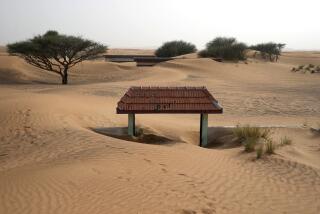In Wake of War, Geologist Worries About Long-Term Damage to a Fragile Desert
- Share via
BALTIMORE — When Egyptian-born geologist Farouk El-Baz saw the dramatic television scenes of allied tanks breaching huge sand barriers to launch the ground offensive against Iraq, his eyes were drawn to the desert floor.
“I was looking at the ground, at the tremendous damage this war was causing to the surface of the land,” he said in an interview in Baltimore. “And I knew the consequences would be felt in the region for decades.”
The world’s concern over environmental damage from the war has so far focused on the twin tragedies of oil wells set afire in Kuwait by retreating Iraqi troops and massive oil spills from sabotaged Kuwaiti petroleum terminals contaminating the Persian Gulf.
But El-Baz warns that the widespread disruption of the desert surface--including as much as 25% of Kuwait’s land area--will cause a doubling of sandstorms and an encroachment of dunes on towns, farms, roads and airports.
“As far as long-term damage, this is a more severe problem” than the spills or the fires, said the 53-year-old geologist, director of the Center for Remote Sensing at Boston University and an expert on Middle Eastern desert geology and the use of satellites for Earth study.
Beginning this week, El-Baz will head a two-week fact-finding mission of scientists sponsored by the Third World Academy of Sciences to assess environmental damage from the war in Kuwait, Saudi Arabia, Bahrain, Qatar, the United Arab Emirates and Oman.
His team will look closely at the impact on the Gulf’s water, beaches and marine life from the oil spills and the impact on the atmosphere from the soot, heated air and sulfur pollutants being spewed out by nearly 600 oil well fires.
El-Baz is particularly interested in the desert, damaged during the 43-day Persian Gulf War by carpet bombing from allied aircraft, by troop carriers and by the widespread bulldozing of trenches and sand berms by both sides.
“I need to see the extent of the desert damage, how fine is the sand, how deep the holes,” he said. “But I can already predict what’s going to happen unless action is taken right away.”
The huge sand expanses in the Middle East are fragile, dynamic systems that are extremely vulnerable to man’s activities, El-Baz reported in the March 8 issue of Science magazine.
As the deserts slowly evolved over 5,000 years, the wind blew away the finer sand grains on the surface and left a stabilizing layer of flattened pebbles ranging from pea-sized to as big as an orange.
El-Baz said that this “desert pavement”--he often refers to it now as a “desert shield”--is “nature’s way of making a surface that the wind can move over unhindered, sheltering the fine-grained material underneath.”
Any disruption of the surface provides fresh material for the swirling wind to carry, and suddenly, the process that took thousands of years to complete must begin anew, with negative effects on the civilizations and their structures that stand in the way.
Thus “a new generation” of sand dunes could begin marching southward along the west side of the Gulf as soon as the winds arrive next month, he said. “The dunes can move quickly. This is a remarkably fluid environment that has no respect for what’s in its way.”
If the wounded desert is left untreated, El-Baz said, communities will have to create at great expense elaborate windbreaks and other means of diverting the restless sands.
The real solution? “Make it flat again. The allies are still there with their bulldozers,” he said. “Then Mother Nature can begin creating a new desert shield.”
More to Read
Sign up for Essential California
The most important California stories and recommendations in your inbox every morning.
You may occasionally receive promotional content from the Los Angeles Times.













